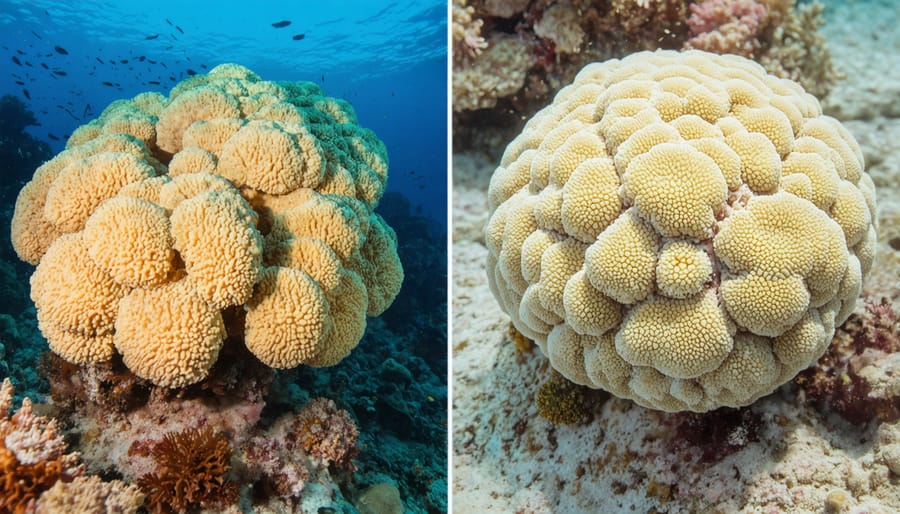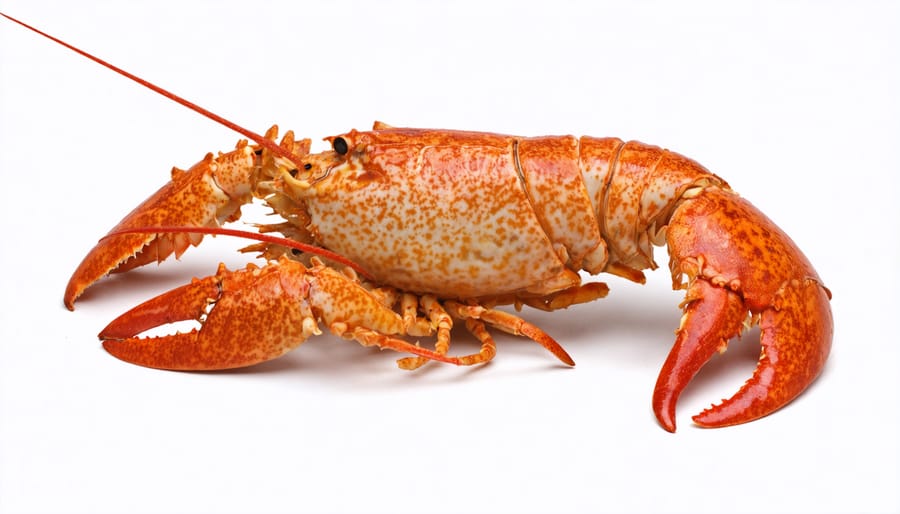
Environmental diseases threaten marine ecosystems with unprecedented intensity, driving declining ocean health and biodiversity loss at alarming rates. From coral bleaching that transforms vibrant reefs into ghostly underwater deserts to sea star wasting disease decimating keystone species along coastlines, these marine epidemics reshape entire ecosystems. Marine scientists have identified three critical environmental diseases that demand immediate attention: eelgrass wasting disease, which destroys essential nursery habitats for commercial fish species; white band disease, devastating Caribbean coral populations; and shell disease syndrome, threatening the survival of economically vital crustacean species. Understanding these diseases – their causes, transmission patterns, and ecological impacts – becomes increasingly crucial as climate change and human activities intensify their spread. Through collaborative research, innovative monitoring techniques, and community-driven conservation efforts, marine biologists and citizen scientists work tirelessly to protect our ocean’s biodiversity from these emerging threats. This exploration reveals not only the challenges we face but also the promising solutions being developed to safeguard marine ecosystems for future generations.
Coral Bleaching: The Silent Killer of Reef Ecosystems

The Science Behind Coral Bleaching
Coral bleaching occurs when corals expel their symbiotic algae (zooxanthellae) in response to environmental stress, primarily triggered by changes in ocean temperature. When water temperatures rise above the coral’s tolerance threshold, typically just 1-2°C above average summer maximums, the symbiotic relationship between coral polyps and zooxanthellae breaks down.
During normal conditions, zooxanthellae photosynthesize and provide up to 90% of the coral’s energy needs while giving corals their vibrant colors. When stressed, the coral polyps expel these beneficial algae, leaving behind their transparent tissue and exposing their white calcium carbonate skeleton – hence the term “bleaching.”
This process is primarily driven by ocean warming, but other stressors can contribute, including:
– Changes in ocean chemistry (acidification)
– Increased solar radiation
– Pollution and agricultural runoff
– Changes in salinity
The bleaching response is actually a survival mechanism, as stressed zooxanthellae produce harmful reactive oxygen species. However, without their primary food source, bleached corals become highly vulnerable. While corals can recover if conditions improve quickly, prolonged stress leads to mortality.
Marine biologists have observed that some coral species and regions show greater resilience to bleaching events. This understanding is crucial for conservation efforts, as it helps identify potential refuge areas and resilient coral populations that might better withstand future climate challenges.
Impact on Marine Biodiversity
Coral bleaching dramatically impacts marine biodiversity by disrupting the delicate balance of reef ecosystems, which support approximately 25% of all marine species. When corals expel their symbiotic algae due to environmental stress, they lose not only their vibrant colors but also their primary source of nutrition. This cascading effect ripples through the entire marine food web.
Marine biologist Dr. Sarah Chen, who has studied the Great Barrier Reef for over a decade, reports that bleached coral reefs experience up to 60% reduction in fish species diversity within the first year. Small reef fish, which depend on healthy corals for shelter and feeding grounds, are often the first to disappear. This loss affects larger predatory fish, sea turtles, and marine mammals that rely on these smaller species for food.
The impact extends beyond immediate reef inhabitants. Coral reefs serve as nurseries for many oceanic species, including commercially important fish. When these nurseries deteriorate, fish populations in surrounding waters decline significantly. Additionally, reef-dependent invertebrates such as mollusks, crustaceans, and sea urchins struggle to survive in bleached environments, further destabilizing the ecosystem.
However, conservation efforts show promise. In areas where water quality improvements and temperature management strategies have been implemented, some coral reefs show signs of recovery. Community-led initiatives, including citizen science projects and coral restoration programs, are helping to monitor and protect these vital marine ecosystems.
Sea Star Wasting Disease
Symptoms and Progression
Each of these environmental diseases manifests differently in marine ecosystems, with distinct progression patterns and warning signs. White Band Disease typically begins at the base of coral colonies, creating a distinctive white band that advances upward at a rate of up to 2 centimeters per day, leaving behind bare coral skeleton. Affected corals show rapid tissue loss, with complete colony death possible within weeks.
Sea Star Wasting Disease presents initially as subtle behavioral changes, with affected stars becoming lethargic and developing white lesions on their surface. As the disease progresses, the stars’ arms begin to twist and eventually detach from their bodies. The final stage, known as “melting,” can occur within 24-48 hours of the first symptoms, resulting in complete tissue deterioration.
Eelgrass Wasting Disease appears as small dark spots on eelgrass blades, which gradually expand into black streaks. These lesions spread along the length of the blade, eventually causing it to weaken and break off. In severe cases, entire meadows can be affected within a single growing season, leading to widespread habitat loss. Environmental stressors, particularly warming waters and reduced light penetration, can accelerate disease progression in all three cases, making early detection and monitoring crucial for conservation efforts.

Ecological Consequences
The decline of sea stars has triggered a cascading effect throughout coastal ecosystems, demonstrating the intricate connections within marine food webs. As these keystone predators disappear, their prey species, particularly purple urchins, have experienced population explosions. This dramatic shift has led to significant environmental health impacts across the Pacific Coast.
The most visible consequence has been the transformation of kelp forests into urchin barrens. Without sea stars to control urchin populations, these herbivores have decimated vast stretches of kelp forests, converting thriving underwater forests into marine deserts. Kelp forests typically provide essential habitat for numerous species, including fish, invertebrates, and marine mammals.
This transformation has rippled through the ecosystem, affecting commercial fisheries, coastal tourism, and local economies. Species that depend on kelp forests for shelter and sustenance have been forced to relocate or face population declines. The loss of kelp also reduces the ocean’s capacity to sequester carbon and buffer coastlines from storm impacts.
Recovery efforts focus on maintaining surviving sea star populations and exploring ways to restore balance to affected ecosystems. Scientists have observed some natural recovery in certain areas, offering hope for ecosystem resilience when given proper protection and support.
Shell Disease in Crustaceans

Environmental Factors
Several environmental factors contribute significantly to the development and spread of shell disease in marine ecosystems. Water temperature plays a crucial role, with warmer waters accelerating bacterial growth and weakening host immune responses. Recent studies have shown that areas experiencing temperature increases of just 2-3°C above historical averages see up to 30% higher disease prevalence.
Ocean acidification, driven by increasing carbon dioxide levels, weakens shell structures and makes organisms more susceptible to infection. When pH levels drop below 8.0, calcium carbonate structures become particularly vulnerable, creating micro-abrasions that serve as entry points for pathogens.
Pollution, especially from agricultural runoff and urban wastewater, introduces excess nutrients that can trigger algal blooms and create oxygen-depleted zones. These conditions stress marine organisms and compromise their natural defense mechanisms. Marine biologists have observed that areas with high nitrogen concentrations show double the infection rates compared to cleaner waters.
Physical damage from human activities, such as bottom trawling and coastal development, creates wounds that become infection sites. Additionally, rising sea levels and changing ocean currents alter habitat conditions, forcing species into new environments where they may encounter unfamiliar pathogens or stressful conditions that compromise their immunity.
Economic and Ecological Impact
The economic impact of marine environmental diseases extends far beyond individual species, affecting entire industries and ecosystems. Commercial fisheries face significant losses, with annual global impacts estimated at over $6 billion. In regions dependent on aquaculture, disease outbreaks can devastate local economies and threaten food security for coastal communities.
These diseases create ripple effects throughout marine food webs. When key species are affected, their decline can trigger cascading impacts on both predator and prey populations. For example, when coral diseases reduce reef coverage, fish populations that depend on these habitats for shelter and feeding grounds diminish, affecting both subsistence and commercial fishing operations.
The ecological consequences are equally severe. Disease outbreaks can reduce biodiversity, alter habitat structure, and disrupt essential ecosystem services. In some cases, the loss of keystone species due to disease can lead to long-term changes in ecosystem functioning. Marine mammals affected by diseases often serve as sentinel species, indicating broader environmental health issues that could impact human communities.
Recovery from these impacts requires significant investment in both time and resources. Conservation efforts, including disease monitoring programs and habitat restoration projects, often strain limited environmental management budgets while highlighting the critical need for preventive measures.
The devastating impact of environmental diseases on marine ecosystems calls for immediate and sustained action from the global community. Through our examination of these three critical diseases, we’ve seen how human activities, climate change, and environmental stressors combine to create perfect conditions for disease outbreaks that threaten marine biodiversity.
However, there is hope on the horizon. Conservation efforts worldwide are making significant progress in addressing these challenges. Scientists and volunteers are working together to monitor disease outbreaks, implement early warning systems, and develop innovative treatment approaches. Marine protected areas have proven effective in building ecosystem resilience, while improved water quality management helps to restore ocean health and reduce disease vulnerability.
Looking ahead, the future of marine disease management depends on our collective commitment to conservation. Emerging technologies, including advanced diagnostic tools and predictive modeling, offer new possibilities for disease prevention and control. Community-based monitoring programs are expanding, enabling faster response times to disease outbreaks and better protection for vulnerable species.
Success stories from various marine ecosystems demonstrate that when we combine scientific knowledge with dedicated conservation efforts, we can effectively combat these diseases. By maintaining this momentum and expanding our understanding of marine diseases, we can work together to protect our ocean’s biodiversity for future generations.
jessica
Ava Singh is an environmental writer and marine sustainability advocate with a deep commitment to protecting the world's oceans and coastal communities. With a background in environmental policy and a passion for storytelling, Ava brings complex topics to life through clear, engaging content that educates and empowers readers. At the Marine Biodiversity & Sustainability Learning Center, Ava focuses on sharing impactful stories about community engagement, policy innovations, and conservation strategies. Her writing bridges the gap between science and the public, encouraging people to take part in preserving marine biodiversity. When she’s not writing, Ava collaborates with local initiatives to promote eco-conscious living and sustainable development, ensuring her work makes a difference both on the page and in the real world.
